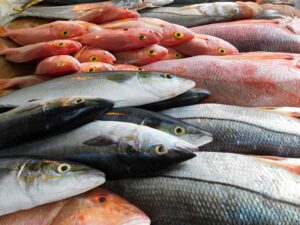Current Situation
The Norwegian seafood industry has long been a significant component of the country’s exports, with the United Kingdom being one of its largest seafood export markets facing issues of declining consumption. According to analyst Eivind Braekkan from the Norwegian Seafood Council, seafood purchases of almost all varieties in the UK decreased last year, with rising seafood prices being one contributing factor. While inflation has played a role in price increases, the decline in seafood demand is not unique to the UK but rather a global trend. This issue could further exacerbate due to global supply shortages.
Specifically, challenges facing Norwegian seafood exports in 2024 include decreased production of Atlantic cod and haddock. Atlantic cod production is expected to decrease by 17%, including a reduction in Norwegian cod, while haddock supply will also decrease by 14%. While Norway may be able to partially fill the global supply gap, the US market’s ban on Russian cod will intensify competition in the seafood market and place greater pressure on the supply chain.
However, Norwegian seafood exports continue to thrive. The latest data indicates exports totaled 13.3 billion Norwegian krone last month, a 3% increase compared to the same period last year. The Norwegian Seafood Council highlights significant increases in the value of salmon, trout, cod, and snow crab, driving export figures to historical highs. Despite global economic turmoil, strong demand for Norwegian seafood remains a primary driver of continued growth in the Norwegian seafood industry.
Norway itself possesses abundant marine resources and aquaculture technology, providing a solid foundation for the development of its seafood industry. With thousands of kilometers of coastline and vast ocean areas, Norway offers ideal habitats for various fish and seafood species. Furthermore, Norway boasts world-leading technology and management expertise in marine aquaculture, enabling efficient and sustainable production of various seafood products.
While China has also achieved some success in seafood exports, Norway surpasses China in certain seafood categories, particularly in non-processed and fresh product categories. Data analyzed by the Norwegian Seafood Council and Beijing-based seafood and meat consultancy firm Seabridge shows continuous growth in Norwegian seafood exports, with stable growth trends in the export volumes of salmon, trout, cod, and snow crab, as well as an increasing proportion of processed product exports. These data indicate that the Norwegian seafood industry remains competitive in the global market and has achieved significant growth.
The latest data shows that Norwegian seafood exports continue to thrive, but there are signs that exports may slow down. The Norwegian Seafood Council indicates that due to substantial increases in the value of salmon, trout, cod, and snow crab, export figures reached historical highs in February. CEO of the Seafood Council, Christian Chramer, stated, “The last time export figures decreased was in February 2021. Over the next 36 months, Norwegian seafood exports have increased compared to the same period last year.” He added, “Despite events such as the COVID-19 pandemic, war breaking out in Europe, and economic sluggishness during this period, demand in the Norwegian seafood market remains strong. Additionally, three years of value growth have been driven by high global price increases and a weak Norwegian krone.” Mentioning salmon last month, there was a clear shift from whole fish to more processed products. Chramer noted that the proportion of fish fillet exports in February has never been higher. The total production in February was 78,522 tons, down 3%, with revenues reaching 9.1 billion Norwegian krone, a 5% increase from the same period last year. Fish fillets accounted for the highest proportion of total exports last month. Seafood analyst Paul T. Aandahl stated that in terms of value, fish fillets and other processed salmon accounted for 30% of exports.

The Hazards Behind the Rosy Report Card
However, a closer examination of the data reveals numerous hazards lurking behind this rosy report card. As one of Norway’s largest seafood export markets, the United Kingdom witnessed varying degrees of decline in purchases across almost all varieties last year. Consumers, amidst soaring inflation and rising living costs, have had to curtail their spending on high-priced items like seafood.
Meanwhile, the supply side faces severe challenges. In 2024, production of Atlantic cod and haddock is projected to decrease by 17% and 14%, respectively, further exacerbating global seafood shortages. This may not only push prices higher and intensify demand softness in traditional markets like the UK but also impact the incomes of Norwegian fishermen and aquaculturists.
On the other hand, Russian seafood, due to sanctions, is set to leave gaping holes in the markets of the US and some European countries, providing an opportunity for exporters from other regions. However, Russian seafood’s poor reputation among the British populace may become a new obstacle for countries like Norway seeking to tap into this market.

Consumers May Be Adjusting Their Habits
Consumers may face the challenge of declining consumption due to rising seafood prices, especially in major markets like the UK. With seafood prices on the rise, consumers may reassess their purchasing decisions, considering reducing their consumption of seafood products or seeking more affordable alternatives. Global supply shortages may further exacerbate price increases, adding to consumers’ economic pressures and prompting them to be more cautious in their seafood purchases. Thus, consumers may need to adjust their consumption habits in the face of rising seafood prices and explore other viable options to meet their dietary needs.
Fishermen and aquaculturists Face Complex Situations
Firstly, they benefit from rising seafood prices, leading to increased income. With the increase in seafood prices, fishermen and aquaculturists can fetch higher prices, thereby boosting their incomes. This is a positive development for them, improving livelihoods and enhancing quality of life.
However, concurrently, production declines may affect the incomes of some fishermen, especially of species like Atlantic cod and haddock. With production decreases, fishermen may not be able to catch enough fish, resulting in reduced income. This could particularly impact the economic situation of those reliant on these species for fishing.

Exporters Face Dual Challenges
Firstly, they face the challenge of declining consumption in major markets like the UK. As seafood prices rise, leading to decreased consumer desire to purchase, exporters may encounter reduced demand in markets like the UK. This directly affects exporters’ sales and market share, potentially leading to decreased income.
Secondly, exporters need to actively explore new markets to address the challenges of increasing global competition. Given the increasingly fierce competition in the seafood market, exporters need to seek new market opportunities to diversify risks and ensure continued business growth. This may involve developing new target markets, expanding overseas partnerships, and strengthening marketing and promotional activities to increase product visibility and sales in new markets.
Therefore, exporters need to adapt flexibly to market changes while constantly seeking new business opportunities and markets to ensure their competitive position and sustained growth in the global seafood market.
For Processing Companies
Firstly, they benefit from the increasing proportion of processed product exports. With the higher proportion of processed products in seafood exports, processing companies will be able to secure more export orders, thereby expanding their market share and increasing revenue. This is a positive trend for processing companies, as processed products typically have higher added value, bringing in more substantial profits.
However, secondly, global supply shortages may lead to rising raw material costs. If seafood raw materials are in short supply, processing companies may have to pay higher prices to obtain the required raw materials. This could increase production costs for companies, reduce profit margins, and potentially necessitate price adjustments to cope with cost pressures. Therefore, while the increasing proportion of processed product exports brings some benefits to companies, global supply shortages remain a potential risk factor that companies need to closely monitor and address.
Continuous Efforts Required from the Norwegian Government and Seafood Industry
To maintain Norway’s leading position in the seafood industry, the Norwegian government and seafood industry must continue to make concerted efforts. The Norwegian government needs to take a range of measures to support the development of the seafood industry. These measures may include providing financial support to help businesses adapt to market changes and challenges, promoting the stable development of the seafood industry. Furthermore, strengthening international trade negotiations is necessary to explore new market opportunities, expand overseas partnerships, and increase seafood exports.
The government can also take measures to promote seafood consumption domestically, to reduce over-reliance on export markets. By promoting consumer awareness and consumption of domestic seafood, the government can conduct publicity campaigns to increase public awareness and trust in Norwegian seafood. Additionally, the government can encourage the catering and retail sectors to increase the supply and promotion of seafood products, launch promotional activities, and stimulate consumer interest in purchasing seafood. Through these measures, the government can promote the development of the domestic seafood market, reduce over-reliance on export markets, and improve the stability and sustainability of the Norwegian seafood industry.
Norway is renowned as the “Land of the Sea,” and the development of its seafood industry is a continuation of this tradition. Only by adopting comprehensive strategies can Norway ensure the stability and vitality of this pillar industry, ushering in new vitality.















